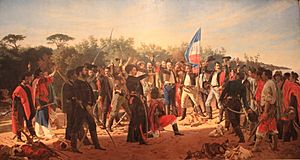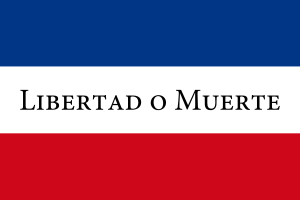Thirty-Three Orientals facts for kids
The Treinta y Tres Orientales (which means Thirty-Three Easterners in English) was a brave group of revolutionaries. They were led by Juan Antonio Lavalleja and Manuel Oribe. Their main goal was to fight against the Empire of Brazil to make their homeland free. Their actions eventually led to the creation of modern Uruguay.
They became famous as the Treinta y Tres Orientales in 1825. This was when they started a rebellion to gain independence for the Oriental Province. This area included what is now Uruguay and parts of Brazil's Rio Grande do Sul State. The group was also known as the Thirty-Three Immortals.
Contents
Why They Fought for Freedom
Between 1816 and 1820, the United Kingdom of Portugal, Brazil and the Algarves took over the Provincia Oriental. This area had been controlled by Spain before. The Portuguese-Brazilian forces easily defeated the local resistance. This resistance was led by José Gervasio Artigas. He had to leave the province in 1820 and went to live in Paraguay.
In February 1824, the Oriental Province was officially made part of Brazil. It was renamed Cisplatina. Brazil had recently become an independent country itself. Before this, a group had tried to make Cisplatina join the United Provinces of the Río de la Plata (which is now Argentina). But the Brazilians stopped this movement.
Planning the Big Move
Juan Antonio Lavalleja was a military leader who had fought with Artigas against the Portuguese and Brazilians. He decided to organize a new military mission. This mission started from Buenos Aires Province and aimed for Cisplatina Province. The main goal was to kick out the Brazilians. They also wanted Cisplatina Province to join the United Provinces of the Río de la Plata.
This expedition got help from some ranchers and beef-curers in Buenos Aires Province. They saw Brazil's control of Cisplatina as a threat to their businesses. Their markets were being hurt by competition from neighbors in Rio Grande do Sul. These neighbors were getting cattle from Cisplatina. Juan Manuel de Rosas, a well-known rancher, became a very important supporter of the anti-Brazilian movement.
The Secret Landing
On April 1, 1825, a small group led by Manuel Oribe sailed from San Isidro. They landed on Brazo Largo island in the Paraná river. The rest of the men left soon after. However, bad weather meant they could only join the first group on April 15.
After dark on April 18, Lavalleja and his men moved carefully. They went through the islands of the Paraná Delta. They avoided being seen by the Brazilian ships. They crossed the Río Uruguay in two boats. At dawn on April 19, they landed at Agraciada Beach, also called "Arenal Grande." There, they raised a special flag. It became known as the Bandera de los Treinta y Tres Orientales (Flag of the Thirty-Three Easterners). This flag had blue, white, and red horizontal stripes. These colors had been important since the time of Artigas. They were used not only in Oriental Province but also in other parts of the Río de la Plata region.
Many years later, in 1877, a painter named Juan Manuel Blanes created a famous artwork. It was called El Juramento de los Treinta y Tres Orientales (Oath of the Thirty-Three Orientals). This painting is one of the most important images in Uruguay's history. Blanes often painted historical events. For this painting, he made sure to show the faces of the people in great detail. He even interviewed some survivors and took many notes.
The Fight for Independence
After landing, the Treinta y Tres Orientales started to gather support. Many people from the countryside joined their cause for freedom from the Brazilians. The group then moved towards Montevideo. They arrived there on May 20, 1825. On June 14, in the town of La Florida, they set up a temporary government. This government then held an election for representatives. This group was known as the Representatives' Hall, or more commonly, the Florida Assembly. The assembly's job was to create new laws for Oriental Province.
On August 25, the assembly made a big announcement. They declared that Oriental Province was independent from Brazil. They also declared their loyalty to the United Provinces of the Río de la Plata. The United Provinces officially accepted Oriental Province on October 24, 1825. This made the Empire of Brazil very angry. Brazil declared war in December of the same year. This was the start of the Cisplatine War.
This war lasted until August 1828. A British diplomat named Viscount Ponsonby helped to find a solution. As a result, Oriental Province became a state independent from both the United Provinces and the Brazilian Empire. This agreement was the foundation of modern Uruguay. It was called the Preliminary Peace Convention. It was officially signed on August 27, 1828.
How Many Were There?
The exact number of people in the group has been debated. This is because different lists of members were published between 1825 and 1832. While thirty-three is the official number, the names on these lists are not always the same. It's possible that some names were nicknames. According to Jacinto Carranza, who studied these lists for his 1946 book ¿Cuántos eran los Treinta y Tres? (How Many Were the Thirty-Three?), the name Santiago Gadea appears on every list.
Even though they were called "Orientales" (Easterners), not everyone was from Oriental Province. Some were Argentines from the islands of Paraná. There were also Paraguayans and even one person born in Mozambique.
See also
 In Spanish: Treinta y Tres Orientales para niños
In Spanish: Treinta y Tres Orientales para niños
- Flag of the Treinta y Tres
- Agraciada Beach#Historical association
- Cisplatine War
- José Gervasio Artigas
- Flag of Artigas
- Empire of Brazil
- Juan Antonio Lavalleja
- History of Uruguay
- Treinta y Tres
- Virgin of the Thirty-Three



